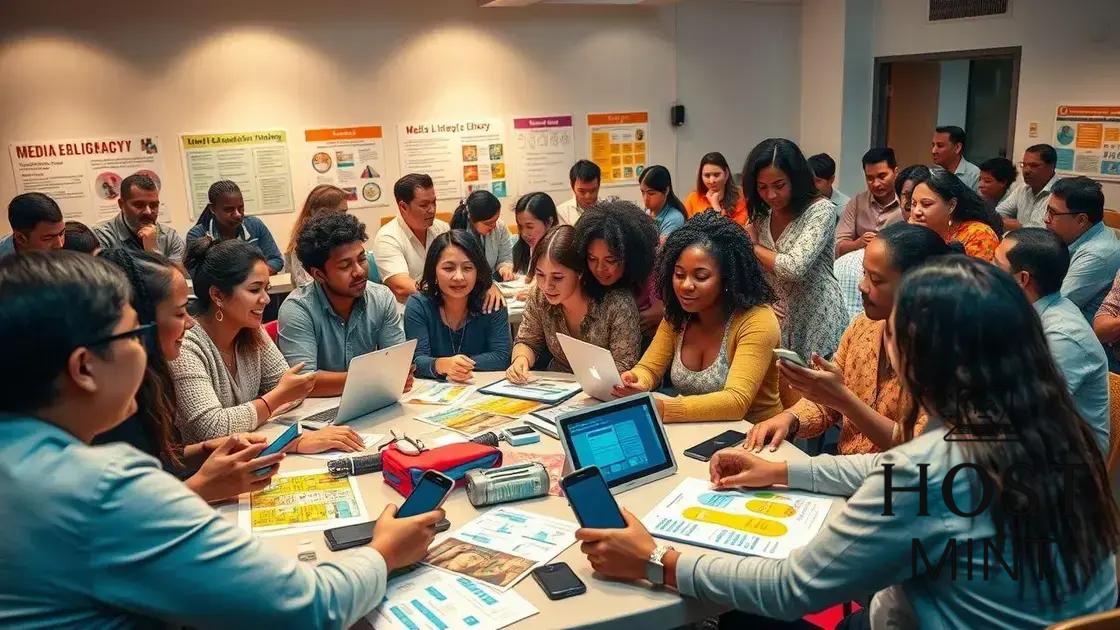Strategies to secure systems from disinformation in 2025

Strategies to secure systems from disinformation in 2025 include verifying sources, utilizing technology, fostering public education, and promoting collaborative efforts across organizations and communities.
Strategies to secure systems from disinformation in 2025 are becoming increasingly vital as our world becomes more interconnected. Have you ever wondered how misinformation spreads and affects you? In this article, we will explore practical methods to enhance your defenses against this pressing issue.
Understanding disinformation threats
Understanding disinformation threats is crucial in today’s digital landscape. With the rise of the internet and social media, it’s easier than ever for false information to spread. This can lead to chaos, confusion, and real-world consequences.
Types of Disinformation
Disinformation comes in many forms, and recognizing these is the first step in combating them. Some common types include:
- False information: Completely fabricated facts.
- Distorted facts: Real information taken out of context.
- Imposter content: Authentic sources manipulated to mislead.
- Fake news: News articles that are untrue or misleading.
Being aware of these types can help individuals and organizations prepare.
The Impact of Disinformation
The impact of disinformation can be significant. It erodes trust and can influence public opinion on critical issues. For instance, during elections, disinformation can sway voters with deceptive messages. It can also incite violence or create division within communities.
Additionally, disinformation can undermine institutions by creating a lack of faith in experts and authorities. This can lead to public health risks, especially during crises, such as pandemics, where accurate information is vital.
Another aspect to consider is how disinformation can spread rapidly across platforms. When individuals share without verifying, they unintentionally become part of the problem. Education on how to identify disinformation is essential.
Ultimately, understanding disinformation threats involves both recognizing the types of misleading information and acknowledging its effects. Learning to think critically about what we see online is essential for everyone.
Key strategies for protection

Key strategies for protection against disinformation are essential in today’s information-driven world. By employing these strategies, individuals and organizations can strengthen their defenses and minimize the impact of false information.
1. Verify Information Sources
Always check the credibility of the information before sharing. Understanding where the information originates is vital. Reliable sources often have a history of accuracy and transparency. Make sure to:
- Look for reputable news organizations.
- Cross-check facts with multiple sources.
- Research authors and their backgrounds.
Verification can prevent the dissemination of misleading content.
2. Educate the Audience
Another effective protective strategy is education. Teaching people how to recognize disinformation is crucial. This includes informing them about certain techniques that disinformation campaigns use. For instance, highlighting clickbait headlines and emotionally-charged language can help audiences identify potentially misleading content.
Organizations should consider running workshops to build media literacy skills. These skills empower people to question the information they encounter. A more informed audience can actively avoid contributing to the spread of disinformation.
3. Use Technology Wisely
Leveraging technology can also play a significant role in protection. There are various tools available that can help identify and combat disinformation. Some of these include:
- Fact-checking websites.
- Browser extensions that flag false information.
- Social media algorithms designed to reduce the spread of misleading content.
Utilizing these resources can enhance your ability to discern credible information.
4. Foster Open Dialogue
Encouraging open discussions about disinformation allows for a collaborative approach to tackling the issue. When people share their perspectives and challenges, it creates a better understanding of the problem. Building trust within communities can also help in combating the negative effects of disinformation.
Finally, engaging in conversations about reliability and credibility helps reinforce the importance of protecting one another from disinformation threats. Everyone has a part to play in creating a safer information environment.
The role of technology in securing systems
The role of technology in securing systems against disinformation is becoming more important every day. With advancements in digital tools, organizations can better protect themselves and their users from the spread of false information.
1. Data Analysis Tools
Using data analysis tools enables organizations to track patterns and identify sources of disinformation. These tools can analyze millions of social media posts and articles to find trends that indicate misinformation.
- AI algorithms: Advanced algorithms can recognize misleading patterns.
- Sentiment analysis: Understanding public sentiment can reveal potential disinformation campaigns.
- Network analysis: Maps out connections between sources to spot unusual activity.
By leveraging these technologies, organizations enhance their ability to react swiftly to threats.
2. Automation and Alerts
Automation can help in monitoring information in real-time. This means organizations can catch disinformation as it spreads. Setting up alerts allows for quick responses, minimizing the spread and impact of false information.
For example, by automating fact-checking processes, companies can flag or remove content that does not meet accuracy standards. This not only helps in safeguarding users but also promotes a culture of truthfulness.
3. Machine Learning
Machine learning plays a key role in understanding and developing responses to disinformation. By training systems on vast datasets, machines can learn to differentiate between reliable and unreliable information. This ability is crucial for filtering content and ensuring that users receive accurate data.
Organizations can integrate machine learning models into their systems to enhance security measures. As these models improve, so does their capacity to detect even the most subtle disinformation tactics.
4. Collaboration Platforms
Technology also enables collaboration among organizations to combat disinformation. Tools designed for teamwork allow different entities to share insights and resources. By working together, organizations can create a stronger front against disinformation campaigns.
These platforms help in pooling knowledge and sharing methodologies. This collective effort can lead to innovative solutions that enhance security and raise awareness.
Building public awareness and education

Building public awareness and education is essential in the fight against disinformation. As more people engage with information online, understanding how to identify and combat misinformation becomes crucial. It empowers individuals and communities to make informed decisions.
1. Community Workshops
One effective method to increase awareness is through community workshops. These events can educate people on recognizing disinformation. Participants can learn how to evaluate sources and verify facts. Workshops can cover:
- Techniques for identifying fake news.
- Understanding the impact of misinformation.
- Tools to fact-check information.
Community engagement creates a platform for people to discuss concerns and experiences, fostering a sense of collaboration.
2. Online Campaigns
Another strategy involves online campaigns aimed at raising awareness. Social media is a powerful tool for spreading information quickly. Governments, nonprofits, and organizations can run campaigns that promote critical thinking and media literacy. These campaigns often include:
- Informative graphics and videos.
- Engaging quizzes to test knowledge.
- Interactive posts that encourage sharing.
Utilizing digital spaces effectively helps reach a broad audience.
3. School Programs
Implementing educational programs in schools is another impactful way to foster awareness among younger generations. Teaching media literacy in classrooms allows students to recognize disinformation from an early age. Schools can integrate lessons on:
- Evaluating online sources.
- Understanding bias in media.
- Practicing responsible sharing.
These skills are essential for navigating the digital world responsibly.
4. Collaboration with Influencers
Partnering with social media influencers can significantly amplify awareness campaigns. Influencers can help spread critical messages to wider audiences. Their platforms can promote educational content that highlights the importance of verifying information. By collaborating with influencers, campaigns can reach diverse demographics and generate meaningful discussions about disinformation.
In essence, building public awareness and education focuses on creating informed communities. It requires a multifaceted approach, combining local engagement, online efforts, educational initiatives, and innovative partnerships.
Collaborative efforts for a safer information ecosystem
Collaborative efforts for a safer information ecosystem are vital in the age of digital disinformation. When organizations, governments, and community members work together, they can create powerful defenses against the spread of false information.
1. Partnerships Between Organizations
One effective way to build a safer information environment is through partnerships. Organizations can share resources, knowledge, and technology to address disinformation more effectively. By collaborating, they can:
- Leverage diverse expertise and perspectives.
- Develop joint initiatives and campaigns.
- Enhance their collective outreach efforts.
These partnerships can lead to innovative strategies that individual organizations might not achieve on their own.
2. Government Involvement
Governments also play a crucial role in establishing a safer information ecosystem. They can create policies that encourage transparency and accountability online. This includes:
- Regulating social media platforms to combat disinformation.
- Supporting research on the effects of misinformation.
- Funding educational programs that promote media literacy.
By taking these actions, governments can help build a resilient public that is better prepared to face disinformation.
3. Community Engagement
Engaging communities is essential for fostering a strong defense against misinformation. Local leaders and organizations can host events and create programs that raise awareness. This local engagement can help individuals:
- Understand the impact of disinformation on their lives.
- Get involved in community efforts to combat false information.
- Connect with others who are committed to creating change.
Building a sense of community is a powerful tool in addressing disinformation.
4. Global Cooperation
Finally, international cooperation is necessary to combat disinformation on a larger scale. Countries can share best practices and learn from each other. Global efforts can help develop standards for addressing misinformation that extends beyond borders. Initiatives such as:
- Multinational agreements on information sharing.
- Joint training programs for media professionals.
- Global campaigns promoting media literacy.
By working together on a global stage, nations can create a united front against disinformation threats.
FAQ – Frequently Asked Questions about Strategies to Secure Systems from Disinformation
What are effective strategies to combat disinformation?
Effective strategies include verifying information sources, educating the public, utilizing technology, and fostering community engagement.
How can technology help in addressing disinformation?
Technology provides tools for data analysis, automation, and machine learning, which can identify and combat misinformation more effectively.
What role does education play in fighting disinformation?
Education promotes critical thinking skills, helping individuals discern credible information and recognize misleading content.
Why is collaboration important in creating a safer information ecosystem?
Collaboration among organizations, communities, and governments leads to shared knowledge and resources, enhancing the collective ability to combat disinformation.






